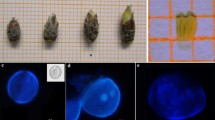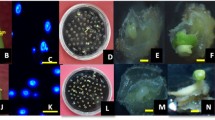Summary
The inheritance of the ability of barley anthers to produce microspore-derived callus in vitro was investigated. The genotypes selected were the two spring cultivars ‘Dissa’ (D) and ‘Sabarlis’ (S), the two F1 hybrids (DxS, SxD), the two backcross generations [Dx(DxS), Sx(DxS)], and an F2 generation derived from DxS. From a number of individuals of each generation, the first five spikes were harvested sequentially and after pre-treatment the anthers were removed and placed in culture. Cultures were scored for microspore callus production and plantlet differentiation. Although ‘Dissa’ gave a significantly higher level of callus production than ‘Sabarlis’, the overall frequencies of green and albino plant production were higher from ‘Sabarlis’. There was no significant difference between reciprocal F1 hybrids. Analysis of variance revealed significant differences in response between the spikes sampled from the plants. This was the major source of variation in the experiment. Spike to spike variation also appeared to be a heritable character.
Similar content being viewed by others
References
Bullock WP, Baenziger PS, Schaeffer GW, Bottine PJ (1982) Anther culture of wheat (Triticum aestivum L.) F1's and their reciprocal crosses. Theor Appl Genet 62:155–159
Charmet G, Bernard S (1984) Diallel analysis of androgenetic plant production in hexaploid Triticale (X. triticosecale, Wittmack). Theor Appl Genet 69:55–61
Chen JJ, Tsay HS (1984) The callus-forming ability of rice anthers originated from tillers of different orders and from spikelets of different positions and branches on the panicles. J Agric Res China 33:354–362
Choo TM, Reinbergs E, Kasha KJ (1985) Use of haploids in breeding barley. Plant Breed Rev 3:219–252
Dunwell JM (1985) Anther and ovary culture. In: Bright SWJ, Jones MGK (eds) Cereal tissue and cell culture. Martinus Nijhoff, Dordrecht, pp 1–44
Dunwell JM (1986a) Barley. In: Evans DA, Sharp WR, Ammirato PV (eds) Handbook of plant cell culture, vol 4. Macmillan, New York, pp 339–369
Dunwell JM (1986b) Pollen, ovule and embryo culture as tools in plant breeding. In: Withers LA, Alderson PG (eds) Plant tissue culture and its agricultural applications. Butterworths, London, pp 375–404
Foroughi-Wehr B, Friedt W (1981) Responsiveness to anther culture of Hordeum vulgare cv. «Dissa’ and its parents. Barley Genet Newslett 11:50–53
Foroughi-Wehr B, Friedt W, Wenzel G (1982) On the genetic improvement of androgenetic haploid formation in Hordeum vulgare L. Theor Appl Genet 62:233–239
Huang B, Sunderland N (1982) Temperature-stress pre-treatment in barley anther culture. Ann Bott 49:77–88
Jayasekara MEM, Jinks JL (1976) Effects of gene dispersion on estimates of components of generation means and variances. Heredity 36:31–40
Jinks JL, Jones RM (1958) Estimation of the components of heterosis. Genetics 43:223–234
Jing J-K, Xi Z-Y, Hu H (1981) Effects of high temperature and physiological condition of donor plant on induction of pollen-derived plants in wheat. Annü Rep Inst Genet Acad Sin Beijing 1981:67–68
Lazar MD, Baenziger PS, Schaeffer GW (1984) Combining abilities and heritability of callus formation and plantlet regeneration in wheat (Triticum aestivum L.) anther cultures. Theor Appl Genet 68:131–134
Lupotto E (1982) Improvement in plantlet differentiation from anther culture of rice. Genet Agrar 36:129–142
Lyne RL, Bennett RI, Hunter CP (1986) Embryoid and plant production from cultured barley anthers. In: Withers LA, Alderson PG (eds) Plant tissue culture and its agricultural applications. Butterworths, London, pp 405–411
Mather K, Jinks JL (1982) Biometrical genetics. Chapman and Hall, London
Nilan RA (1964) The cytology and genetics of barley 1951–1962. Monographic Suppl No 3, Res Stud Washington State University
Orlikowska T (1977) Induction of androgenesis in vitro in Secale cereale and Triticale. Genet Pol 18:51–59
Powell W, Dunwell JM (1986) In vitro genetics of barley (Hordeum vulgare L.): Response of immature embryos to 2,4-dichlorophenoxyacetic acid. Heredity 58:75–80
Author information
Authors and Affiliations
Additional information
Communicated by F.Salamini
Rights and permissions
About this article
Cite this article
Dunwell, J.M., Francis, R.J. & Powell, W. Anther culture of Hordeum vulgare L.: a genetic study of microspore callus production and differentiation. Theoret. Appl. Genetics 74, 60–64 (1987). https://doi.org/10.1007/BF00290084
Received:
Accepted:
Issue Date:
DOI: https://doi.org/10.1007/BF00290084




